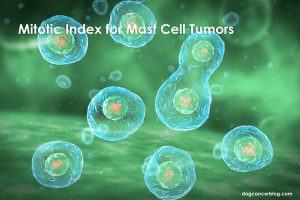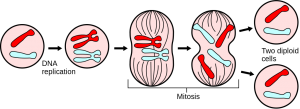
Mitotic index –mast cell tumor.
by Demian Dressler, DVM
From the Dog Cancer Blog
There is a lot of uncertainty in canine cancer, and mast cell tumors are the tumor type that proves it.
Mast cell tumors are tricksters, with seemingly benign tumors sometimes turning out to be very aggressive … and often enough to be confusing, vice versa. When we’re talking mast cell tumors, we are definitely in what I call “the gray zone.” Determining just how aggressive the tumor is up front is important when it comes to making treatment decisions, which is why Dr. Ettinger, my oncologist co-author, suggests looking at the mitotic index for mast cell tumor assessment.
The most common instance of confusion in mast cell tumor diagnosis is for the grade 2 mast cell tumor. As you may already know, the “grade” is a measure of how aggressive a cancer is. When we say a cancer is a “high grade malignancy” we mean it is hard to cure. A “low grade” growth is easier to cure as a generality (but not always), usually by surgical removal.
Grading Mast Cell Tumors
In mast cell tumors, the grade is usually broken down into three levels, with grade 1 being the lowest and grade 3 being the highest and most aggressive. (There is also a newer, 2-tiered system of grading mast cell tumors that may be available to your oncologist and may be useful in real “gray zone” cases.)
So, if your dog has a grade 3 mast cell tumor, it’s considered aggressive cancer. Aggressive cancers do things like regrow in the same spot even after surgery (recur) or spread to surrounding areas (local invasion). Aggressive cancers can also spread to distant sites … places like the spleen, liver, bone marrow, or other remote areas, which is called metastasis.
If your dog has a grade 1 mast cell tumor, thankfully, it’s considered less aggressive. This means that it is likely going to be cured with a surgery with wide margins that gets the whole tumor out. This doesn’t mean that grade 1 is ALWAYS cured with a surgery — just that it is more likely to. And make sure you ask for wide margins!
Grade 2 mast cell tumors are intermediate, by definition, and highly unpredictable. These are the tumors that earn mast cell tumors their nickname “the trickster.” Grade 2 mast cell tumors can behave aggressively (like grade 3’s) or more like benign growths (grade 1’s).
It’s grade 2 mast cell tumors that can most benefit from a mitotic index measurement. The number will be on your biopsy report.
Get the Biopsy!
You will not know the grade of your dog’s mast cell tumor until after the biopsy is performed, of course, so you can’t use the mitotic index for mast cell tumor assessment until AFTER you get that tumor surgically removed (with wide margins, please!).
If you are looking at a grade 1, the likelihood that your dog will need more treatment is low. For a grade 3 tumor, which is seriously aggressive, you are almost certainly going to get more treatment recommendations. But what about that gray zone, the grade 2 mast cell tumor?
There are a couple of ways to treat a grade 2 mast cell tumor. You could do a second excision (surgery) with wider margins. You could add chemotherapy and/or Palladia to your treatment plan. But which action plan to take is in the gray zone until another bit of information:

Mitosis
Mitosis
Mitosis is a part of cell division, the way that cells replicate themselves. You can actually see mitosis happening in cells under a microscope. It looks something like this.
To get the mitotic index, the pathologist looks at a slide with a very thin slice of your dog’s tumor tissue on it. The tissue has been stained so it is colored and they can easily see which cells are dividing (in mitosis). They simply count the numbers of these cells to get the mitotic index. The higher the number, the higher the mitotic index and the more aggressive the tumor.
If you think about it, this will make sense. The more cancer cells divide, the faster they replicate themselves, the bigger the tumor, and the bigger the problem for your dog. More cell division, faster growth, higher mitotic index.
Mitotic Index Mast Cell Tumor
So what does the mitotic index actually mean for mast cell tumors?
Well, generally, a lower mitotic index is better. Fewer dividing cells = a less aggressive cancer.
For grade 2 mast cell tumors, the magical number to hope for is a mitotic index of 5 or less. These dogs, with conventional care alone, have a median survival time of 70 months, or nearly six years. That’s a nice long median survival time.
Unfortunately, dogs with grade 2 mast cell tumors with a mitotic index of greater than 5 have a dramatically shorter median life expectancy of only 5 months. This is quite a dramatic difference.
Here is the abstract to show you where I am getting this information.
Bottom Line: How to Use the Mitotic Index for Mast Cell Tumor
Again, you might not really need to consider the mitotic index if you get a grade 1 or 3 tumor. In those cases, your direction will be more clear-cut.
But in cases where we have a grade 2 mast cell tumor, the mitotic index (MI) can help you make decisions about what to do next.
If you have a grade 2 mast cell tumor with a mitotic index of <5, your minimum treatment surgery with a wide excision of 2 to 3 centimeters. If you have that already, you might not need any more treatments, but your oncologist might want to use other steps, including chemo and/or radiation. With a median survival time of 70 months, taking those extra steps might not feel necessary in every case. (Remember, I don’t make direct advice over the internet, because every case is different. I’m not saying that you should not get extra treatment if your dog’s MI is under 5. I’m just saying in general, they may not be as necessary.)
But in cases where we are looking at grade 2 mast cell tumors with a mitotic index of <5, these cancers should be considered very, very dangerous and aggressive. If your dog is young, and you would expect her to live a long time if she weren’t sick, you might be more aggressive with the treatments than you would if the MI were <5. I would certainly consider chemo and radiation with your oncologist. If your dog is close to or beyond his average life expectancy, I would suggest it is time for ethical considerations and maybe a focus on life quality enhancement.
Regardless of the grade of tumor or the mitotic index, your dog will benefit from the dog cancer diet, supplements, life quality enrichment, and the other complementary aspects of care Dr. Ettinger and I cover in detail in our book The Dog Cancer Survival Guide.
Best,
Dr D
About the Author: Demian Dressler, DVM
Dr. Demian Dressler, DVM is known as the “dog cancer vet” and is author of The Dog Cancer Survival Guide: Full Spectrum Treatments to Optimize Your Dog’s Life Quality and Longevity.








